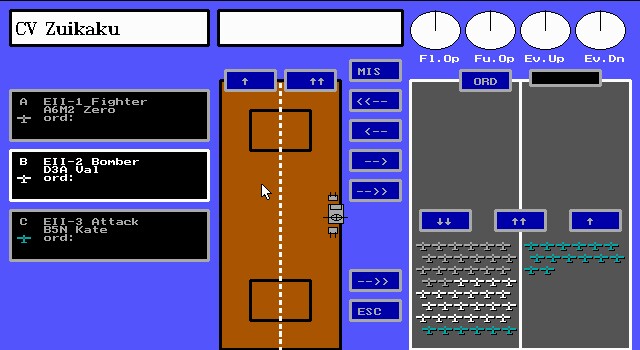
Actual Game
Carrier Strike1-Click Install
|
This game follows in the footsteps of SSI's Second Front (Russian Front WW2) and continued their series of grand tactical/strategic simulations set in World War 2. It is aimed at people who are not so much interested in simulators but rather in the machinery which gets opposing forces into battle in the first place.
There are two players (Allied, Japanese) and either, both, or neither can be played by humans. The game runs 26 months of game time and allows for one battle of up to four game days duration each month, so the Campaign Game is long.Turns are 20 minutes each. Game units are Task Forces (Surface Action, Air Combat--your carriers, Transport, Bombardment), Strikes (air units), Airbases (land installations mainly run by the com- puter for both sides) and submarines, which are also managed by the computer.
You can also play single battles (Coral Sea, Midway, Marianas etc.) of which there are six.
The game map covers an enormous area stretching from Truk in the North, to Townsville, to Espiritu Santo, and North again. The Midway and Marianas battles use different maps around those areas. The areas are divided into hexes (not visible) 17 miles across.
The objectives overall are to sink enemy fleet and, within each monthly battle, to gain extra victory points by achieving your Transport or Bombardment (of coastal airfields) Missions. Your specialised Task Forces for these missions need air support, and this is where your Air Combat TFs come in--to engage the opposing carriers, or, by maintaining air superiority over your objectives, to drive away enemy missions and fulfil your own.
The heart of the game, and what makes it such fun, is the hidden movement system. That is, at the start of each battle, the players have no idea where the opposing forces are, other than in the very general terms outlined in the Battle Plan given to each player by Strategic HQ (i.e. the computer) every month. The computer then places the forces on the game map.
Given the huge size of the play area, the essence of success is locating the enemy and bringing your forces to bear at greatest advantage in range and numbers. This captures the flavour of the warfare--beware nasty surprises!
Once the enemy is found, you may be able to launch airstrikes and inflict some damage. On the other hand, if the enemy is out of range, you have to move to within strike range (risky) to do this, all the while being mind- ful of the possibility of enemy strikes on your precious carriers. If your casualties are too high, Strategic Command (the computer) will intervene and order General Withdrawal, forcing you to quit the battle area. This is to prevent overly aggressive players making unrealistic decisions, for example using crippled carrier forces as Surface Combat units.
The game system gives a very realistic idea of the problems of commanding naval forces in WW2. It enables skilfully handled small forces to defeat much larger ones, and really makes the game worthwhile.
After joining battle, the players make their dispositions during the mutual Orders Phase in each turn. That is, one at a time, and hidden from the other player, you bring planes up from the hangar deck, fuel and arm them, move them onto the flight deck, and fly them off. Each step takes one, 20-minute turn.
This is crucial, since enemy strikes can arrive while planes are being prepared and at this point, one lucky bomb hit will see your carrier a blazing wreck.
Both sides have primitive radar, but it does not indicate whether a strike is arriving or leaving. Hence, multiple strikes can inflict huge damage if the enemy commander decides to risk fueling planes after one enemy strike departs.
This combines the possibility of strategic surprise (via hidden forces) with tactical surprise (strikes attacking at staggered intervals). The style of play is up to you--you can be conservative and not fuel up while ANY enemy strikes are around, but will you miss an opportunity by doing so?
In the end this is a simple game to play, though quite long, and despite the small number of playing pieces (2-12 per side) there is plenty for the player to think about as the game progresses. As the fleet commander for the South Pacific area, you can do no more than make your best dispositions with the forces available and trust to your luck. This is quite reasonable for a period when the soldiers, not the munitions, had the smarts!
Carrier Strike tests reasoning and decision-making rather than reflexe and is one of the best naval combat games of the early 90s.






